
Dear Readers,
Welcome to the first issue of Sunday Extra. This is a new monthly feature in which I delve a little deeper into Italian cooking. One of my aims is to take a closer look at traditional Italian dishes and to put them in context. This is also where I’ll be sharing more involved recipes, occasional seasonal menus, and more. As I mentioned in my first newsletter of this year, I’m putting few limits on this feature; I just want to see where it takes us. (Today it’s taking us to Abruzzo.) Although this is a premium newsletter, most of its contents are available to all subscribers, with the recipe behind the paywall.
Next week, we’ll be back to our regularly scheduled Sunday newsletter with something sweet for all.
It snowed in Abruzzo last week. My Instagram feed was a stream of forest trails steeped in white and glowing mountain villages, all the houses huddled together, their roofs thickly frosted.
Here in Virginia, where the winter palette has been mostly brown and gray, all I could think about was climbing into one of those vignettes and making my way through the snowy landscape to La Lanterna, a small beacon of a bar-ristorante in Castiglione Messer Raimondo, a few miles up the road from our little place in Penne. I would plant myself in a chair and order a bowl of Signora Rita’s scrippelle ‘mbusse.
Certain dishes seem made for snowy days—cheese fondue comes to mind, and rich onion soup. And for me, scrippelle ‘mbusse—crêpes in broth. The dish is a specialty of Abruzzo’s Teramo province, which is bordered to the west by the slopes of the Gran Sasso mountain range. Not many people realize that the highest peak in Italy outside of the Alps is in Abruzzo. The Gran Sasso d’Italia is part of the Apennines, the chain of mountains that forms Italy’s “backbone.” The corno grande (big horn), the Gran Sasso’s tallest peak, rises to 2,912 meters—nearly 10,000 feet.
Not surprisingly, winters in the towns and villages around the Gran Sasso can be harsh. In addition to hearty plates of spaghetti alla chitarra con ragù, the Teramani keep warm with this nourishing, old world soup.
“È un piatto della tradizione,” Massimo Conocchioli tells me. This translates to, “It’s a traditional dish,” but there’s a note of reverence here. The Abruzzesi are proud of their culinary heritage (no matter where you go in Italy, if you say you’re from Abruzzo the refrain will invariably be an enthusiastic “In Abruzzo si mangia bene!”). Massimo is the consulting chef at Le Virtù, a restaurant in Philadelphia that specializes in Abruzzese cuisine. He grew up in Colonella, a hilltop town north of Teramo, and remembers his mother and grandmother making crêpes in broth on Christmas Day.
The name “scrippelle ‘mbusse” is Teramana dialect for “crespelle in brodo.” For a long time I was stumped by the word ‘mbusse,’ until I found a recipe for the dish in Anna Gosetti della Salda’s wonderful cookbook, “Le Ricette Regionali Italiane.” In that book, the dish is called “scrippelle ‘nfuss.” It dawned on me that “‘mbusse” and “‘nfuss” are simply dialect for infused. So: broth-infused crêpes.
There’s a story about how this dish came to be, though whether it’s true or not I can’t say. It dates to the beginning of the 18th Century, when French forces were stationed in Teramo during Napoleon’s brief reign. A sous chef named Enrico Castorani who was tasked with feeding the officers always served them crêpes in place of the local bread, a rustic loaf made with cornmeal. One day, a batch of crêpes he had prepared went tumbling into a pot of boiling broth. Rather than throw them out, the chef served up the happy accident.
Teramana cuisine features crêpes in other dishes, too. They take the place of pasta in cannelloni and in the Abruzzese version of lasagne, called “timballo di crespelle.” It’s a rich, layered affair with cheese, tiny meatballs, sausages, and ragù. Scrippelle ‘mbusse, meanwhile, is an example of the province’s cucina povera. The batter for the crêpes is eggs mixed with flour and diluted with water. “Rigorosamente con acqua, niente latte,” (strictly with water, no milk) says my friend Elvira Zilli, who lives in Rome but whose family is from Campotosto, over the border in the province of L’Aquila.
However, at Le Virtù, Massimo makes his scrippelle with milk, as did his mother and grandmother, though he suspects they did this to provide him with extra nourishment. The broth for scripplle is typically made from chicken parts or a stewing hen. Massimo seasons his with a little orange peel, cinnamon, and clove. The ingredients should simmer “piano, piano,” he says, without boiling, to avoid clouding the broth.
Gianluca Delle Monache, owner of La Lanterna, says some families serve scrippelle in pork broth, since winter is when pigs are slaughtered and processed. Or it might be a chicken broth in which veal or beef bones have been added to bolster the flavor. It is Gianluca’s mother, Rita, who does the cooking at this olive oil mill-turned-bar, including making scrippelle (she uses water in her batter). If you go to Castiglione MR, you can’t miss it. It’s a bright yellow building at the edge of the main piazza. But you need to call a day or two in advance if you want Signora Rita’s scrippelle.
Scrippelle ‘mbusse is not a dish from my childood. My mom was from Chieti, farther south in Abruzzo, and closer to the coast. In her day, local dishes really didn’t travel, so there’s no reason why scrippelle would have been on her radar or in her repertoire (though the cookbook I referenced earlier was hers and no doubt she would have read through the chapter on Abruzzo). I’m not exactly sure when I first came across the dish, probably when I was researching The Glorious Soups and Stews of Italy—there’s a recipe in the book. Even in Italy, though, it’s not widely known; I recently mentioned it in passing to two Italians from different regions (one north, one south) and neither had heard of it.
Laura Ottaviantonio, an Instagram acquaintance from Abruzzo who writes and photographs the beautiful blog Ricette e Vicende, told me that scrippelle ‘mbusse showcases a quintessential ingredient pairing in Abruzzese cuisine: eggs and pecorino (sheep’s milk) cheese. “There are always eggs and pecorino in Abruzzese dishes,” she wrote in a message exchange, “with lamb, with stewed peppers, with pallotte cace e ovo (egg and cheese ‘meatballs’). It’s the greatest resource, one that a population of shepherds couldn’t do without.” (translation mine)
One reason I wanted to write this post, beyond the fact that this wonderful dish needs to be shared, is that I wanted to tweak my own recipe for scrippelle. Although I love the version in Glorious Soups (I’ve linked to it below) it is definitely a contemporary take. The crêpe batter is made with goat’s milk and is thicker than traditional scrippelle batter, so the finished crêpes are also a little thicker—they absorb broth nicely but lack the gossamer lightness of traditional scrippelle. Over the last few weeks, I’ve tested numerous recipes and egg-to-flour-to-water ratios, including some old recipes that call for ‘half an eggshell’ of water per egg, or ‘one spoonful of flour per egg’ plus ‘acqua q.b.,’ which is to say however much water it takes to get the right consistency.
“La pastella deve correre” (the batter has to flow), says Le Virtù’s Chef Massimo, in order to yield the thinnest possible crêpes that still hold together. Below are tips for making proper scrippelle ‘mbusse, plus my newly minted recipe. You can also check out my original recipe from The Glorious Soups and Stews of Italy, which was published awhile back on the Italy Magazine website.
Tips for Making Scrippelle ‘Mbusse
Making these thin crêpes is not especially difficult, but it can be a little tricky. Here are some tips to help you master the process. Don’t worry if you don’t get it right the first time. With a little practice you’ll be turning out light, velvety crêpes.
Broth: There is no point in making scrippelle ‘mbusse without homemade broth because the broth is everything here. The crêpes absorb it like sponges—think of the dish’s name, “infused crêpes.” Homemade broth takes time, but it is easy and worth it. It’s a good stay-inside project for a cold or rainy Saturday or Sunday. Make a lot and freeze it so you’ll have it at the ready when you want to make scrippelle!
Here’s my basic homemade broth recipe. This recipe contains beef marrow bones; if you’d like straight chicken broth, leave out the bones. You can embellish the broth with a little orange peel and cinnamon, as Le Virtù chef Massimo does. Or, if you have a homemade broth recipe that you love, use that instead.
Eggs: Find a good source for eggs if possible. I buy eggs at the farmers’ market when I can. Not only do they taste better (in my opinion), but they also tend to have more nutritional value than mass-produced supermarket eggs. If you’re lucky, you might find eggs with deep orange yolks, the sort you see in Italy (Italians call the yolk “il rosso,” or “the red”). A “red” yolk doesn’t necessarily make the egg better; color is determined by the laying hen’s diet. But deep-colored yolks will make prettier, golden-hued crêpes.
Mixing the batter: Beat the eggs first. Then sprinkle in the flour, whisking vigorously until all the lumps have been worked out of the batter. If you want to be extra-cautious, you can sift the flour into the eggs. Once the mixture is smooth, add the water, a little at a time, until you have a loose pourable batter, like thin cream. If you have a stand blender or a Vitamix, you can use it instead of a whisk, but it’s just one more appliance to clean up.
The pan: You need a nonstick pan to make the crêpes. I use either a well-seasoned (I’m talking 70+ years of seasoning) cast-iron pan or an everyday nonstick pan. You don’t need a fancy crêpe pan (remember those?). Either an 8-inch (20-cm) or a 9-inch (23-cm) works here.
Buttering the pan: The bottom of the pan should be coated with a very light film of fat. The most traditional Teramana recipes use pork fat to grease the pan, which is what my friend Elvira uses. It adds a hint of smokiness to the flavor of the scrippelle. I use butter because I always have it on hand. I take half a stick of butter, still in its wrapper, and rub the end of the stick around the bottom of the heated pan, then use a paper towel to evenly coat the pan and wipe out any excess. Too much butter will prevent the crêpe from properly forming. Towards the end of making the crêpes, the paper towel will be pretty saturated with butter, and you can just use that to grease the bottom of the pan.
Essential tools: A small, angled spatula is indispensable for lifting the edge of the crêpe from the pan in order to turn it. The other essential tools are your fingers (see Flipping the crêpe).
Pouring the batter: This is the trickiest part of making scrippelle. The batter must be thin enough to flow around the entire bottom of the pan. I use a 1/4-cup measuring cup to pour the batter directly into the hot pan, then I immediately lift and tilt the pan around to distribute the batter evenly. You might get a few thicker trails of batter here and there, but things tend to even out when you flip the crêpe. Scrippelle should not brown, so flip the crêpe as soon as it is set—after about 30 seconds.
Flipping the crêpe: Theoretically, a long, wide spatula should work. But it doesn’t always flip the crêpe neatly and then you find yourself trying to adjust it and smooth out wrinkles and folds. This can be tricky, and you risk tearing the crêpe. The best way I’ve found is to lift up the edge of the crêpe with your angled spatula; then use the fingers of both hands to quickly turn the crêpe over. There’s a little heat involved, but I’ve never burned myself and I’ve found nothing works better than my own fingers (people forget what essential tools our hands are in the kitchen).
Assembling the crêpes: Just a tablespoon or two of finely grated Pecorino (or Parmigiano) cheese is all you want for each crêpe. Sprinkle it over the entire surface and then roll the crêpe up like a cigar.
Serving: Lay the prepared crêpes in warmed soup plates and ladle boiling broth over them. The broth really should be boiling to properly warm the crêpes and soften the cheese; and warmed plates will keep the broth from cooling down too quickly.
RECIPE: Scrippelle ‘Mbusse
Eggs and pecorino cheese are paired together in many Abruzzese dishes, a reflection of the region’s pastoral heritage. Here, the two meet in a nourishing soup of delicate crêpes simmered in homemade broth. It’s hard to imagine, on a cold, snowy night, a dish more appetizing than this one: rich, yet delicate, the broth and crêpes glowing golden beneath a soft, snowy shower of grated cheese.
Be sure to warm your bowls in a low oven before serving; this will keep the scrippelle and broth from cooling to quickly as you serve them.
Makes 6 servings
INGREDIENTS
6 large eggs
1/2 teaspoon fine sea salt
Scant 1 1/4 cups (150 g) unbleached all-purpose flour
1 1/2 cups (350 ml) water
Pinch of freshly grated nutmeg (optional)
8 to 9 cups (2 L) homemade chicken broth
Butter for the pan
About 2 cups (180 g) finely grated Pecorino Romano cheese (use a microplane)
INSTRUCTIONS
1. Crack the eggs into a bowl and add the salt. Whisk well to completely break up and combine the eggs. Whisk in the flour, once again whisking vigorously to smooth out any lumps. Gradually pour in the water, whisking as you pour. Grate a small amount of nutmeg into the batter and stir. Let the batter rest for 30 minutes.
2. In a saucepan, bring the broth to a simmer over medium heat.
3. While the broth is heating, make the crêpes. Set an 8-inch or 9-inch (20-cm or 23-cm) nonstick or well-seasoned cast-iron skillet over medium heat and film the bottom with butter. The butter should sizzle upon contact with the pan. Wipe the bottom of the pan with paper towel to distribute the butter and remove any excess; too much butter will prevent the crêpe from forming properly.
4. Pour in a small ladleful of crêpe batter into the hot pan—about 3 tablespoons (45 ml) if you are using an 8-inch (20-cm) pan and a scant 1/4 cup (60 ml) if you are using a 9-inch (23-cm) pan—and quickly tilt the pan around so that the batter coats the bottom, forming a thin pancake. Cook for about 30 seconds, or until just set—the batter will go from shiny to dull as it cooks, and you may see a few bubbles forming beneath the surface. Using a small offset spatula, lift up the edge of the crêpe and use your fingers to carefully flip it over. Or slide a large, wide angled spatula under the crêpe and carefully flip it, smoothing out any wrinkles or folds that form. Cook for another 20 seconds or so, until just done. The crêpe should be fully set but not brown. Transfer the crêpe to a large plate.
Continue making crêpes until you have used all the batter, adding butter to the pan as needed to prevent sticking. Stack the crêpes on the plate as you go (you don’t need to put anything between them; they won’t stick together). You should end up with 24 (8-inch/20-cm) or 18 (9-inch/23-cm) crêpes. Don’t worry if you don’t get that many the first few times you try; it takes practice to get that many crêpes from the batter.
5. Sprinkle a little pecorino—about 2 tablespoons—on each crêpe and roll into a cigar shape. As the crêpes are rolled, place them, seam side down, in warm shallow bowls or soup plates, 3 or 4 crêpes in each bowl.
6. Turn up the heat under the broth to bring it to a rolling boil. Ladle the boiling broth over the crêpes—they don’t need to be completely immersed—and sprinkle a little more pecorino cheese on top. Serve hot hot hot!
As always, thank you for reading, subscribing, and sharing. Now go forth and make scrippelle!
Alla prossima,
Domenica




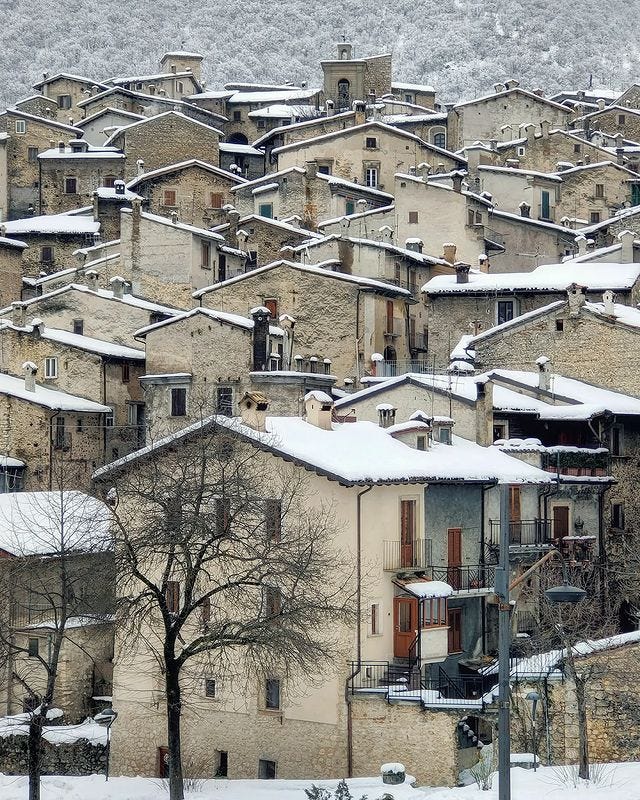
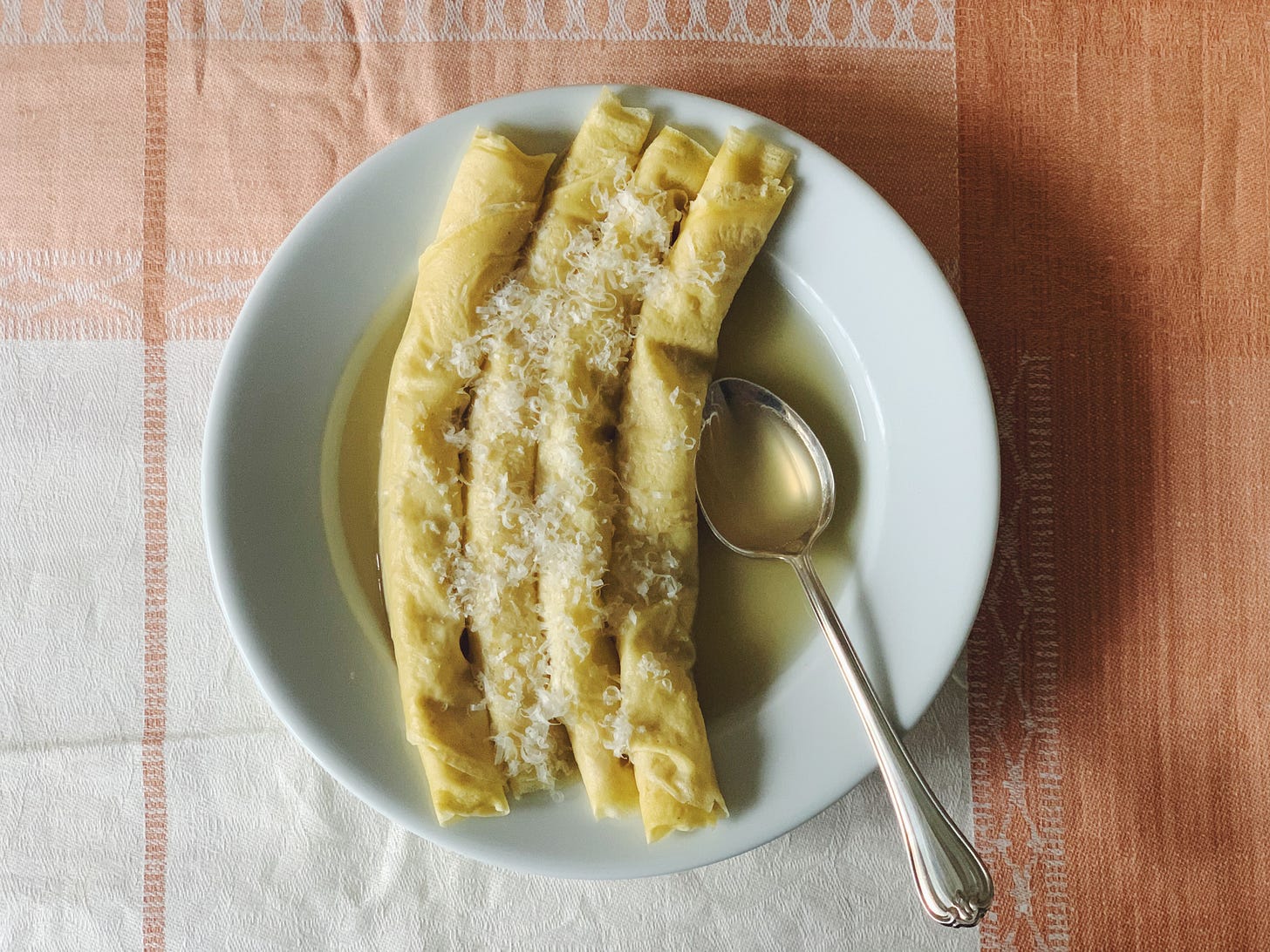

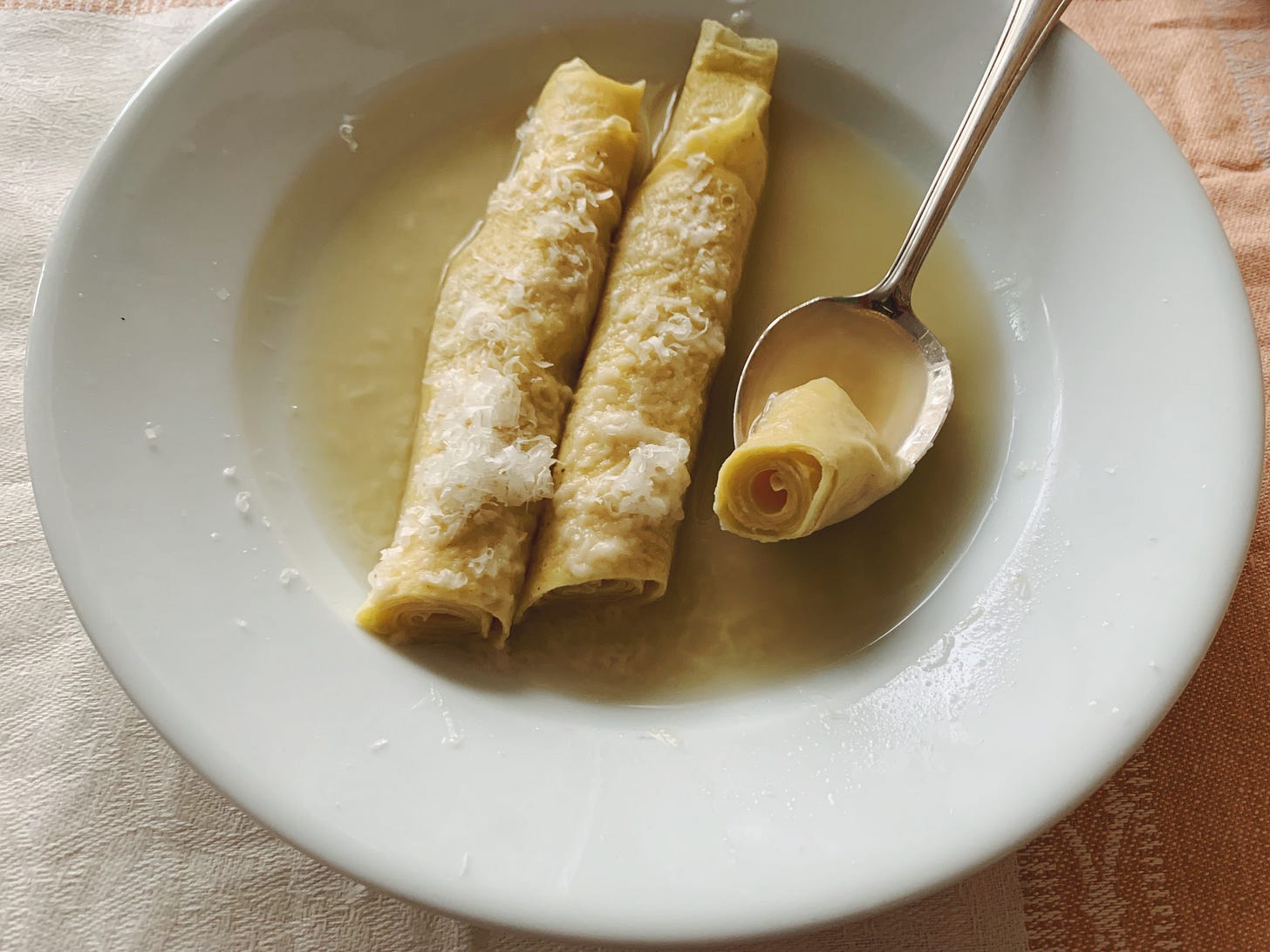
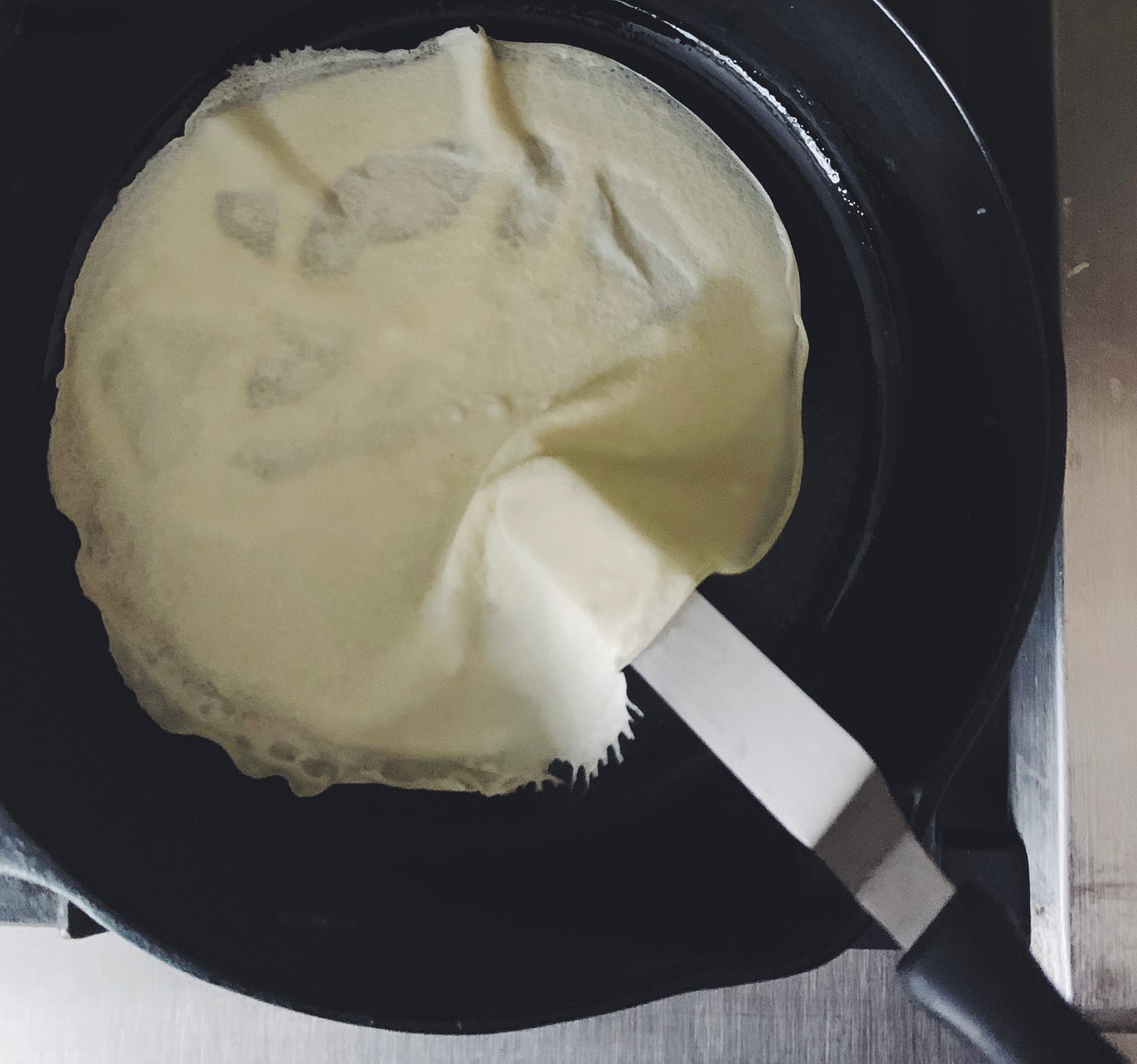
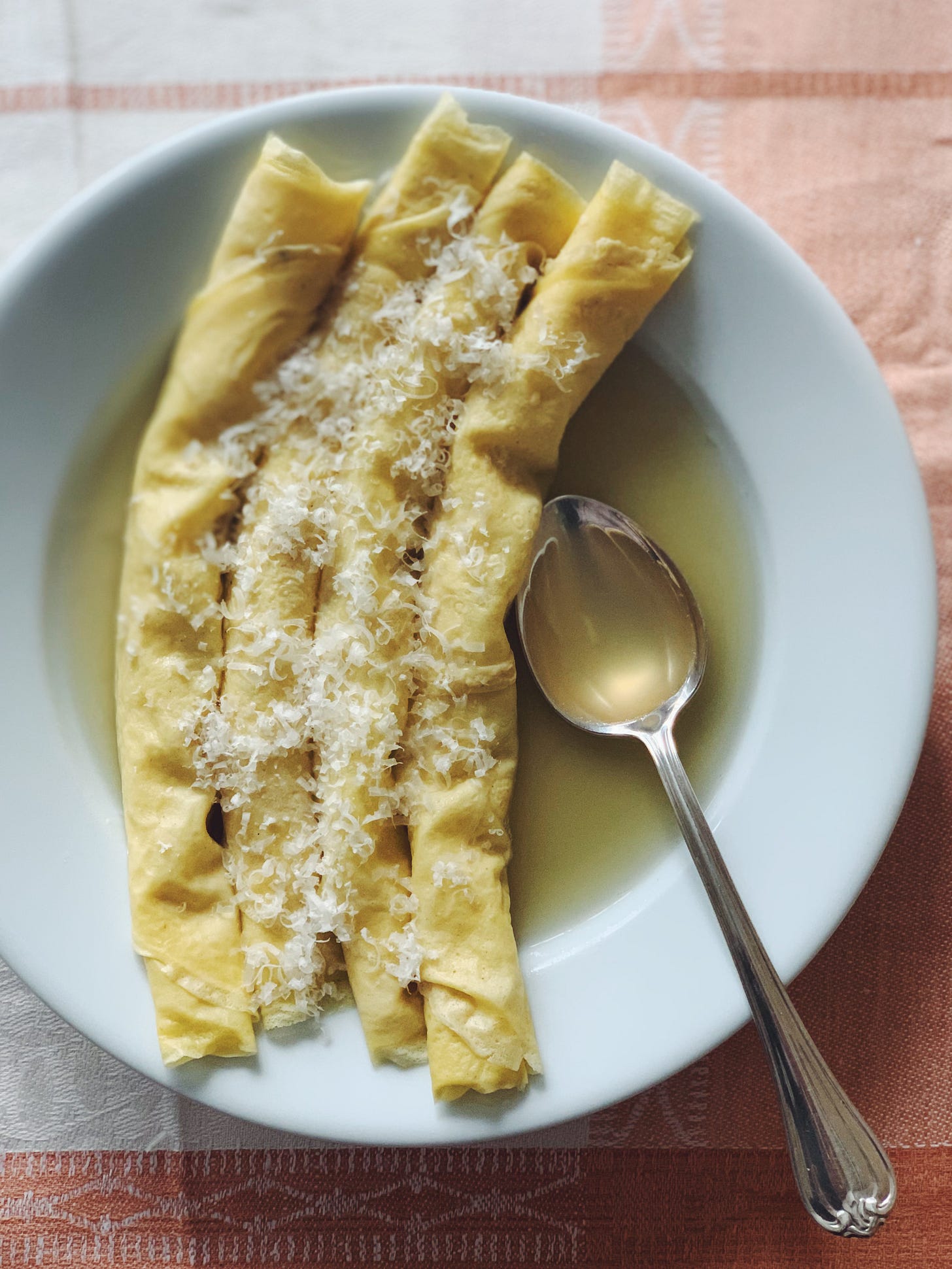
I saw a video that included the crepes being cut up to resemble noodles. I already make crepes, so I asked friends what this dish is, and they told me Scrippelle, which is how I found your great article. I'm going to subscribe, and I'm looking forward to making the recipe. I've been making crepes for years, so I'm not worried about the technique.
Because of this recipe, I’ve subscribed!!
Just wondering if the crepes could be made ahead of time and gently warmed before serving?
Thanks